The beginning of the one-day offensive
prehistory
The second battle on the Marne - the last decisive offensive of the German army on the Western Front, did not lead to victory. The Allies knew about the time and place of the enemy strike and repelled it. Then they counterattacked and drove the Germans back to their old positions, which they occupied before the spring offensive. 2 August French troops liberated the city of Soissons from the Germans. By 5 in August, the Allied counteroffensive on the Entente in the Reims area had exhausted. However, the strategic initiative passed to the allies.
The German army was exhausted and demoralized. Last hopes to successfully end the war collapsed. True, the German command still did not believe in defeat, underestimated the enemy and overestimated its strength. The Russian military historian, General Andrei Zayonchkovsky, wrote: “It (the German command is the Author) also had 204 divisions, of which 70 were in reserve. Under these conditions, Hindenburg decided not to abandon the initiative and undertake new, necessarily sudden offensive operations, but on a reduced scale, both towards the coast and on other sectors of the front, in order to improve their situation, inflict losses on the allies and show them that German power is far from being broken. This circumstance, according to the main German command, could even incline the Entente to peace negotiations. ... But the command, having lost the initiative, did not quite clearly imagine that the crisis on Marne was the beginning of the end of world war. This alone can explain the desire of him to undertake the offensive again, despite the daily increasing superiority of the allied forces and means. ” The plans of the German command on the new offensive will not be realized: in just three days, on August 8, the strategic attack of the Entente troops will begin.
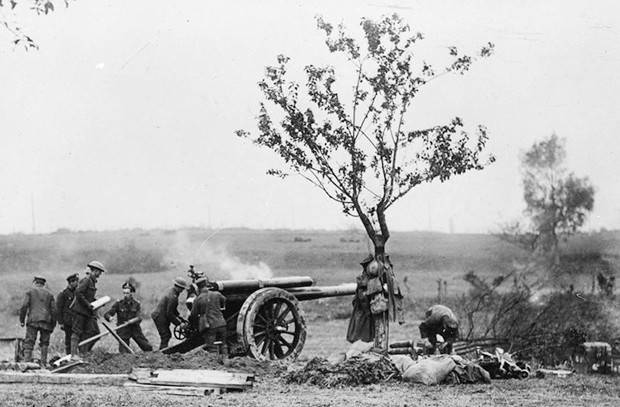
British gunners during the one-day offensive. August 1918 of the year
Party plans
24 July 1918 was held in Bombon in a meeting of the commanders of the allied armies of Petain, Haig and Pershing. The commander-in-chief of the troops of the Western Front, General Foch, outlined a plan for further operations. The main idea of this plan was to abandon the defense and go on the offensive. The directive of 24 July, the Allied command provided for a series of offensive operations separated by short periods of time with the aim of eliminating the ledges in the front line formed as a result of the German spring offensive, as well as the Saint-Mielsky ledge. This allowed the release of a number of railways, necessary for the further development of the offensive. The threat to the northern mining region and the ports of Calais and Dunkirk was also eliminated. If these operations were carried out successfully and in a short time, then it was planned to go on a general, decisive offensive in order to crush the entire German front and not allow the enemy, as it was before, to withdraw to the previously prepared rear positions. At the same time, Foch’s plan was very cautious. The Allied command, overestimating the resistance force of the German army, hoped to end the war only in the 1919 year.
The general conditions for the Allied offensive were favorable: by August, 1,2 million soldiers and officers of the American army had already been transferred to France. Allies gained numerical superiority. The British also gathered all their forces into a fist, transferring even part of the troops from Palestine to France, where fighting with the Turks took place.
The first operation planned by the Allies to eliminate protrusions on the front line was the Amiens operation. Planning it, the command of the Entente hoped to clear the Amiens ledge from the enemy, to eliminate the threat to Amiens and the Paris-Amiens railway, and also to break up and throw away the German troops between the Somme and Avr rivers.
The German High Command still hoped to turn the tide in their favor and achieve a good world for Germany. When the Chief of Staff of the 4 Army, General F. Lossberg, proposed to withdraw troops from the territories seized in the spring and summer of 1918 to the old positions without a fight, thereby straightening the front line and avoiding unnecessary losses, he was refused. Ludendorff replied: “I consider your suggestions to be correct, but I cannot follow them for political reasons.” The rejection of the offensive and the withdrawal of troops to the old positions meant the recognition of the collapse of all hopes of Germany and its allies to win the war, as well as the futility of offensive operations that led to such huge losses.
2 August Ludendorff signed a directive to the commanders of army groups, which stated: "The situation requires that we, on the one hand, go on the defensive, and on the other, - as soon as we have the opportunity, we would launch the offensive again." It was planned to conduct a number of small offensive operations to improve the tactical position in Flanders, in the region of r. Oise, east of Reims, and also at the site of the army group of the Duke Albrecht. Thus, the Germans overestimated the results of their previous offensive operations, their own forces, believed that the Allies were bloodless and incapable of major operations in the near future.
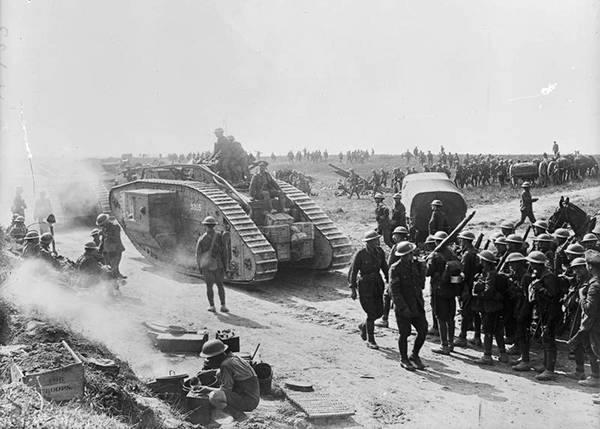
37th British Division, Tanks Mark V of the 10th battalion of the tank corps and captured 4,2-inch German guns during the Hundred Day Offensive. August 1918
Preparation of the operation
The British 4, French 1 and 3 French armies under the general command of Field Marshal Haig were involved in the operation. On the first day, August 8, the 25 th British and left flank 4 corps of the 31 French army launched an offensive on the front in 1 km from Albert to Moreil. Then the offensive of the 3 Army and the rest of the 1 Army should begin. The offensive grouping included 17 infantry and 3 cavalry divisions, 2684 artillery guns, 511 tanks, 16 armored vehicles and around 1000 aircraft. The forces of 2 of the German army von de Marwitz defending this section of the front had 7 infantry divisions, 840 guns and 106 aircraft. The Germans in the area in August were located frazzled and weakened in the previous battles. A big advantage of the Allies over the Germans was the presence of a large mass of tanks. The flat terrain allowed active use of tanks.
At the same time, the advanced units of the 4 of the British army had already fought small battles since spring to improve their tactical position. As a result, the 2-I German army by the beginning of August, almost completely lost the range of military escort and defended in positions that were not fully developed in depth. The British, the results of these battles, as well as on the basis of aerial photography and tactical reconnaissance data, long before the onset of the attack made up a complete picture of the German defense system.
The Allies, using the successful experience of the German offensive, abandoned powerful and long artillery training. The start of the offensive was set to 4 hours 20 minutes. It was planned after the passage of the line of the advanced infantry units by tanks with all artillery to open a sudden fire. A third of the artillery was to create a barrage, and the rest of the artillery - to fire on infantry and artillery positions, command posts, reserves approach ways. The rampart for three minutes was supposed to hold on to the advanced German positions. During this time, tanks and attacking infantry had to come close to the firing shaft and immediately follow him. The fire shaft was to be carried out in jumps, first in 2 minutes, then in 3 minutes, and later in 4 minutes. The left flank of the 1 of the French army launched an offensive after the 45-minute artillery preparation.
The order of the offensive was also clearly planned. After 2 hours after the start of the attack, in 6 hours 20 minutes, infantry and tanks were supposed to reach the first line of attack - a line at a distance of about 3 km from English trenches. Then the promotion was suspended for two hours. At this time, artillery tightened. The attack resumed in 8 hours 20 minutes and lasted continuously until the second boundary, which was located in 4,5 - 8 km from the initial position, and then without interruption to the third boundary at a depth of 9 - 12 km. The cavalry corps, attached to the 4 of the English army, was to perform in 8 hours 20 minutes, overtake the battle formations of the infantry, seize the third frontier and hold it until the main forces approached, and then develop success further. Finally, the thick morning fog, reinforced by the French and the British with smoke and chemical projectiles, contributed to the special success of August 8 operation.
Another feature of the operation was complete secrecy. The whole area of the concentration of allied forces was covered aviation, due to the good condition of the railways, 230 military echelons and more than 60 trains with ammunition were transferred to the offensive area. Artillery took its positions in the last 2-3 days before the offensive, and tanks on the night of August 8. To mislead the enemy in the Ypres region, by order of the English command, extensive demonstrative actions were carried out. As a result, when in the last days before the offensive, reports of suspicious activity in the rear of the enemy began to arrive from advanced German positions, and aerial reconnaissance reported the movement of the tank column, the German command did not pay much attention to this.
British military historian Neil Grant wrote: “Huge efforts were made to provide an element of surprise: even the British military office was not informed about the attack. 4-I army of General Rawlinson was doubled, but it was done so that the Germans did not know. Some Canadian units, which the Germans considered the British assault troops - their presence meant a quick offensive - were pointedly sent to Flanders. ”
Map source: Campaign 1918 French Theater. The battle of Mondidier - Amiens from August 8 to September 25.
Source: A. Zayonchkovsky. World War 1914-1918 Volume III.
Battle
8 August 1918. In 4 hours 20 minutes, allied artillery opened powerful fire on positions, command and observation posts, communications centers and rear facilities of the German Army 2. At the same time, part of the artillery organized a barrage of fire, under the cover of which the divisions of the 4 British Army, accompanied by 415 tanks, launched an attack. Suddenness was a success. The Anglo-French offensive was a complete surprise to the German command. Fog and massive explosions of chemical and smoke projectiles closed everything that was further 10-15 meters from the positions of the German infantry. Earlier than the German command was able to sort out the situation, a mass of tanks hit the Germans' position, firing on the move from the machine guns of meeting soldiers and destroying the telegraph and telephone lines. As a result, the headquarters of several German divisions were taken aback by the rapidly advancing British infantry and tanks, which further aggravated the disorder in the German ranks.
The breakthrough of the enemy defense developed methodically, almost in full accordance with the developed plan. By 6 20 minutes, the troops of the 4 of the British army basically reached the first line of attack. Two hours later, after the artillery was pulled up, the offensive was resumed, and by the 13 watch of 30 minutes the Allies reached the third line at a depth of about 11 km. However, further attempts of the British and French troops to advance into the depths of the enemy’s defense broke about the strong resistance of the German divisions, hastily being transferred to the area of a breakthrough from other sectors of the front. The German troops lost a day before 27, thousands of people killed and captured, about 400 guns, as well as a large number of various military equipment. Allied aviation, which entered the battle as soon as the fog cleared, shot down an 62 German aircraft.
9 August Allied offensive continued. The 1-I French army fully entered the battle, and on August 10 the 3-I French army. The offensive was now conducted on the entire front from Albert to the r. Oise, but it developed slowly. The Germans fought back, transferred reserves and prevented a breakthrough. Fights were already local. German artillery was reorganized to conduct anti-tank defense, as a result of which British and French tanks suffered significant losses. So, 8 of August from 415 tanks, which entered the battle on the site of the 4 of the British army, failed about 100 machines. On August 9, only 145 tanks took part in the attack, of which 39 were put out of action by German artillery fire. Large tank losses had an impact on reducing the rate of advance. 12 August tanks no longer participated in the battle, and the remaining tanks were relegated to the rear. On August 12, battles were fought only on certain sectors of the front, on August 13, the Allied advance was completely stopped.
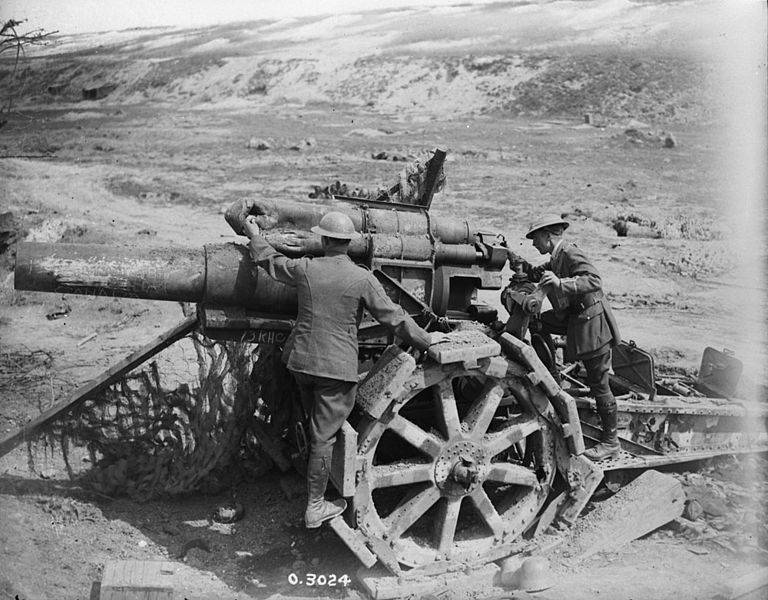
Captured German gun. August 1918
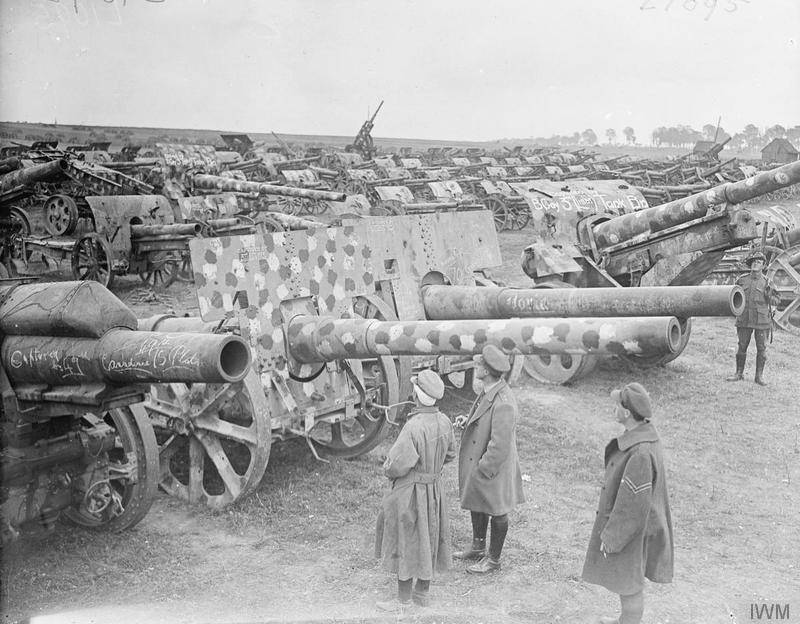
German guns captured in the battle of Amiens by the British army 4
Results of the Battle of Amiens
For five days, the Allies managed to advance deeper into the enemy defenses 3 – 18 kilometers on the front of 75 kilometers, eliminating the threat to Amiens and the Paris-Amiens railway. During the entire operation, the Germans lost 74 thousand people (of which 33 thousand prisoners), allies 46 thousand people. The morale of the German troops was seriously broken: in the units intended for the transfer under Amiens, discontent was shown, there were cases of mass desertion.
The military success of the Allied forces was due to the complete secrecy of the operation, the Germans did not suspect anything; Also, the Allies successfully chose a breakthrough area, where the German defense had the least depth. The success was also due to the Allies' considerable superiority in strength, thorough preparation, suddenness of the strike and massive use of tanks. However, the methodical advance of 8 August from the turn to the turn with a two-hour delay on the first of them led to great losses, gave the German troops the opportunity to recover from the first shock caused by the sudden attack and re-arrange for active defense. Then the Germans pulled up the reserves and stopped the enemy, while the Allies could not turn the tactical breakthrough of the front into operational, using the advantage in cavalry and tanks.
The victory had a tactical significance, the German front could not be broken through, but the victory near Amiens finally consolidated the strategic initiative for the Entente. After the battle, Ludendorff wrote: “August 8, 1918, represents the blackest day of the German army in stories World War. The German army moved to a strategic defense. The troops received an order: "Not to leave an inch of land without a fierce struggle."
13 August 1918 was a meeting of the German command, Chancellor Gertling and the State Secretary of the Foreign Office, Ginze, at the German High Command Headquarters in Spa. All were depressed by the situation. Ludendorff reported that the German army was no longer able to break the enemy with an offensive; It is also impossible to achieve peace through defensive actions, despite the underwater war. Therefore, to end the war should proceed to peace negotiations. The next morning, a meeting of the Crown Council was held in Spa, chaired by Kaiser Wilhelm II, at which it was decided to begin peace negotiations with the Entente through the Queen of the Netherlands. Arriving at the 14 Spa in August, the Austro-Hungarian Emperor Karl, Foreign Minister Burian and Chief of General Staff Arts von Straussenburg joined this decision. However, negotiations with representatives of the Entente have not been started. Hindenburg still hoped that the German army would hold out on the territory of France and Belgium, which would make it possible to conclude a profitable peace.
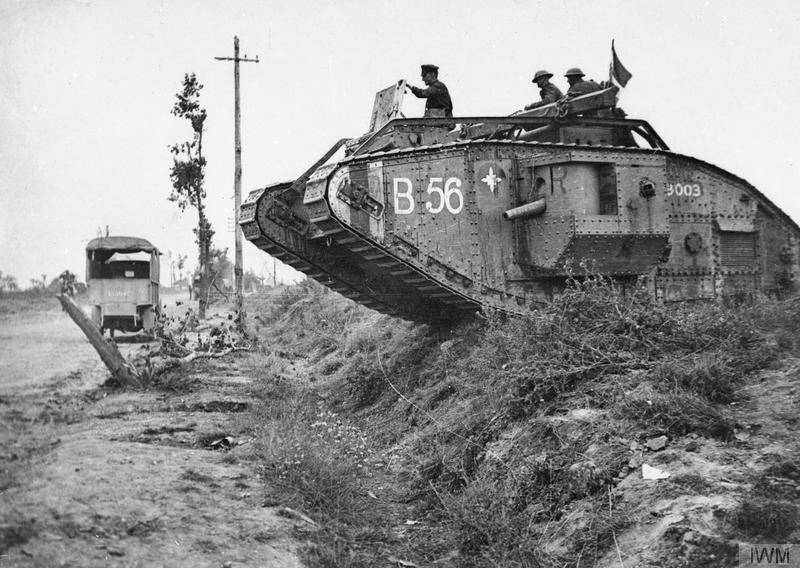
British tank Mark V. August 1918 of the year
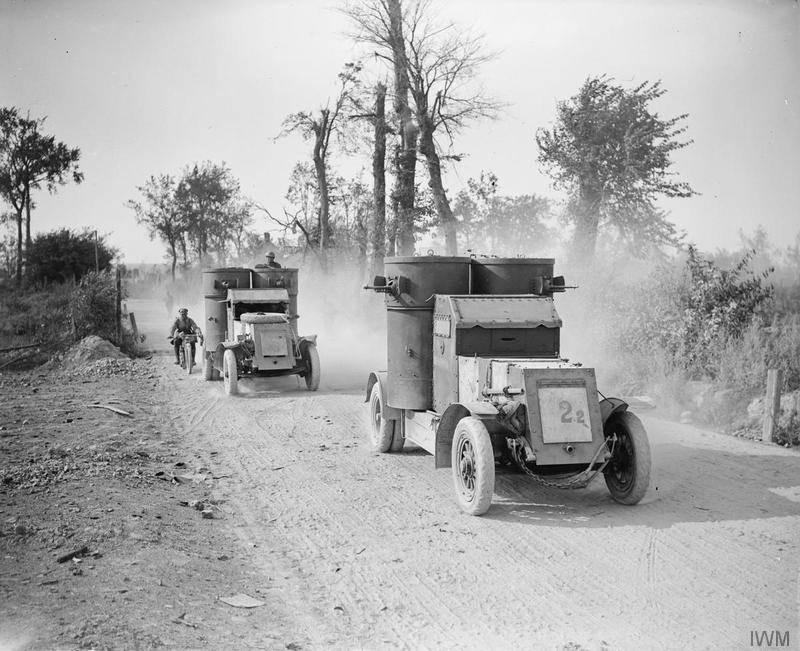
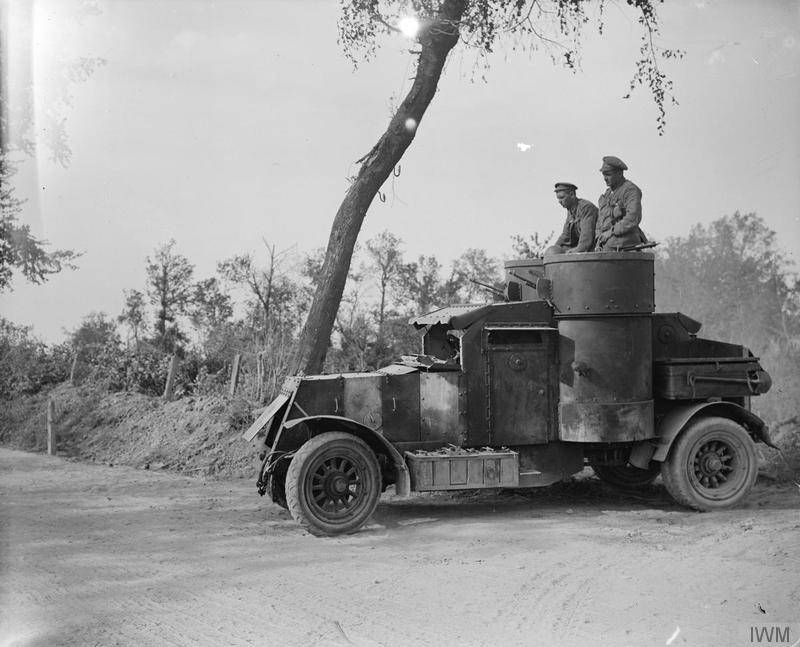
Armored cars during reconnaissance. Second Battle of the Somme. 25 August 1918
Second Battle of the Somme
After the Battle of Amiens, the Entente troops began to expand the front of the offensive on the flanks of the advancing 4 British, 1 and 3 French armies and push the enemy to Siegfried. To the north of the Somme, the 3 of the British army was supposed to be launched in the general direction of Bapom, Peronne. South of the Somme in the offensive in the direction of the Shawnee passed 10-I French army.
On the morning of August 20, the 10 of the French army launched an offensive against the German 9 on the front from Soissons to r. Oise. By August 23 it advanced to the line of the rivers Oise and Ellet. 21 August in the north, fighting against the 1 of the German army on the twenty-kilometer front from Albert to Arras began the 3-I of the English army. By the end of 26 August, she entered the Brae line, Bapom, moving forward 10 km. On this day, the 1-I British Army also joined the offensive. 29 August, she entered the line Bulkur, Drokur. The Allied offensive forced the German command to withdraw the 17, 2, 18 and 9 armies to the line Krausil, Bapom, Peron, Noyon. In the last days of August, the Germans preferred not to get involved in bloody battles, but again to retreat to the well-fortified Hindenburg line (Siegfried line), from which they began their spring offensive. Thus, from 8 to 30 in August, the armies of the Entente on the front from Soissons to Arras advanced in 150 km in the center to 35 km, and on the flanks - on 15 - 20 km.
On August 30, the Allied offensive continued, first on the flanks and then in the center, with the aim of preventing the German forces from gaining a foothold in front of Hindenburg’s position. So, the 31 of August began the battle for Mont Saint-Quentin. Here against the Germans were the Australian part. On the night of August 31, the Australians successfully crossed the Sommu in a key location of the German defense, in a river bend. After seizing the German trenches, 1 September, the Australians liberated the city of Peron itself and forced the enemy to retreat east to the Hindenburg line. 2600 Germans were captured. The loss of Australians during the battles that lasted until September 3 amounted to about 3000 people.
The threat from both flanks forced the German command 2 of September to order the further withdrawal of the 17, 2, 18 and 9 armies on the front between the Scarn and Vel rivers in the length of 160 km to the Hindenburg position. The departure began on the night of September 3 and passed almost without interference from the enemy. September 8 German troops occupied most of those positions on the front from Arras to r. Ellet, from which they began the spring offensive. In early September, the German troops themselves cleared the ledge on the river. Fox Thus, the first part of the plan of offensive operations by the Allied armies, planned by Foch, was successfully carried out. It only remained to oust the enemy from the Saint-Mielsky bulge, which was formed in September 1914.
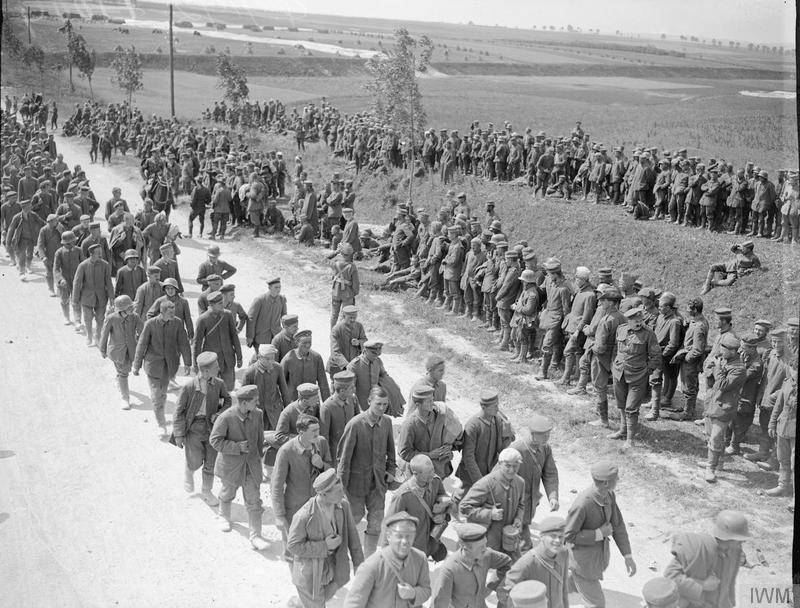
German prisoners arrive in a temporary camp near Amiens. 9 August 1918 of the year
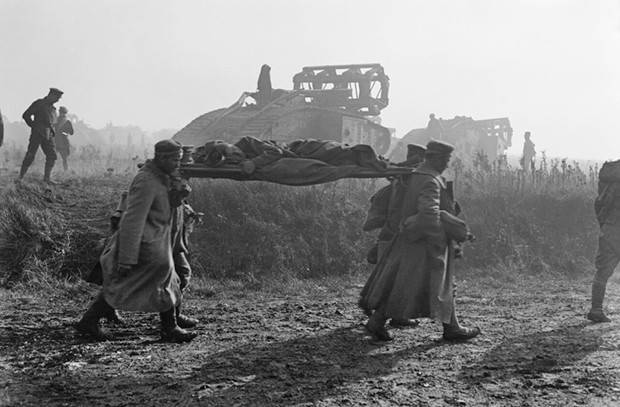
German prisoners are wounded. September 1918 of the year
- Alexander Samsonov
- 1918 Campaign
[leech = https: //topwar.ru/134251-strategiya-mirovogo-gospodstva-ssha.html]
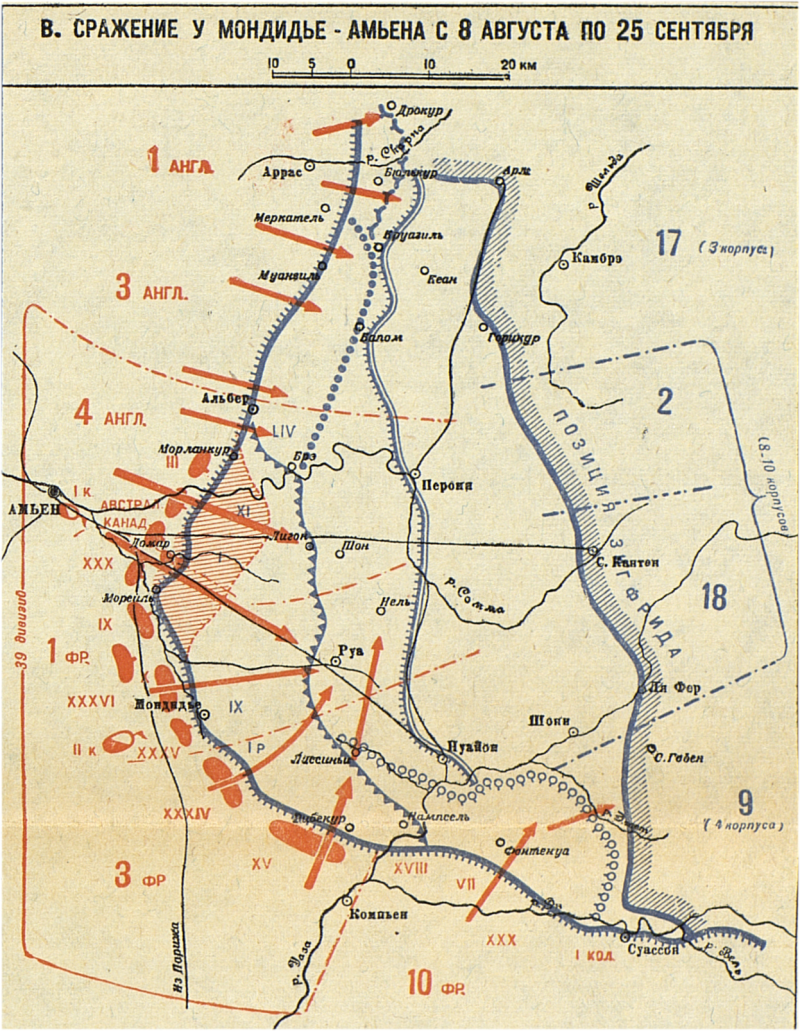
Information